Are you a Quiet Speculation member?
If not, now is a perfect time to join up! Our powerful tools, breaking-news analysis, and exclusive Discord channel will make sure you stay up to date and ahead of the curve.
With the tournaments now over for more than a week, I'm doing the last of my lazy Gerry Thompson impressions before everyone forgets about SCG States altogether. (Really) old rogue strategies like Blue Moon and Eternal Command saw some success at States, but I'm primarily interested in the tournament's brand-new midrange decks. I've divided the decks in this article into two categories: attrition-based and permanent-based midrange.
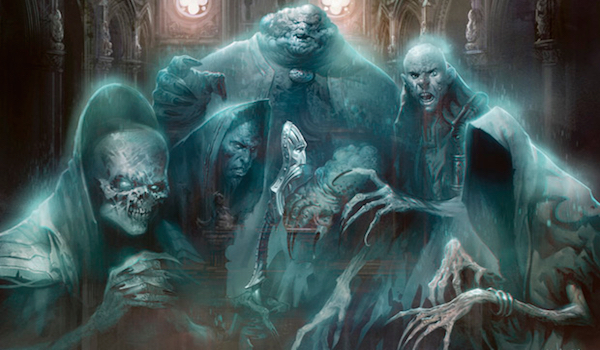
(This article is the second in a two-part series on rogue Modern decks from SCG States. If you haven’t read part one, check that out first!)
[wp_ad_camp_1]
SCG States: Attrition-Based Midrange
When most people think of midrange in Modern, they imagine lines like Inquisition of Kozilek into Abrupt Decay into Liliana into Tarmogoyf. Jund and Abzan exemplify the disrupt-then-commit approach common among attrition-based midrange decks. These strategies grind opponents to a stump before smashing them with lumbering beaters.
Esper Gifts
The first deck I'm presenting isn't much of a midrange deck, landing closer to control on the spectrum. I first heard about it from Jeff Hoogland, about a month before Matthew Szabo took it to 4th place. It plays like a cross between Esper Control and 4C Gifts, including Goryo's Vengeance as a way to begin looping Obzedat, Ghost Council or to instantly nuke boards with Elesh Norn, Grand Cenobite.
Esper Gifts, by Matthew Szabo
In a deck that can reanimate fatties as devastating as Griselbrand, why does Esper Gifts opt for ghost grandpa? There's his obvious synergy with Goryo's Vengeance - pilots can stack the triggers to get Obzedat back the turn after reanimating him. But beyond that, Obzedat has all the hallmarks of a must-respect Modern threat.
For starters, he's 5/5. These stats beat out Tasigur, the Golden Fang, Siege Rhino, and most Tarmogoyfs. Considering the importance of that extra power point on Gurmag Angler, I think 5/5 will be the new standard for Modern fatties, and Obzedat helps lead that movement.
Then, there's his enters-the-battlefield ability. Siege Rhino taught us the potency of a 187 Lightning Helix, and while three trumps two, Obzedat's four-point swing still impacts both life totals more than a single Lightning Bolt.
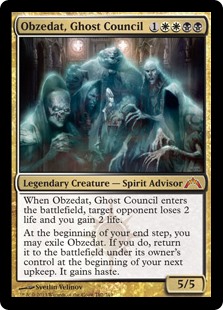 Lastly, Obzedat's blinking ability recycles this baby-Helix. A single Siege Rhino trigger can cause massive paradigm shifts in a game, and as soon as Obzedat's blinked once, he's already done better than the Abzan posterbeast. The blinking ability also gives Obzedat some added resiliency, saving him from sorcery-speed removal like Liliana of the Veil and Roast. That limits the Modern playables that can even deal with the ghost to Dismember, Terminate, and Path to Exile, making it even better than Rhino in some ways. In another States Top 8, Chris Magner brought the Spirit Advisor to a 5th-place finish. He played a Bitterblossom-based Abzan Midrange variant that forewent Siege Rhino entirely.
Lastly, Obzedat's blinking ability recycles this baby-Helix. A single Siege Rhino trigger can cause massive paradigm shifts in a game, and as soon as Obzedat's blinked once, he's already done better than the Abzan posterbeast. The blinking ability also gives Obzedat some added resiliency, saving him from sorcery-speed removal like Liliana of the Veil and Roast. That limits the Modern playables that can even deal with the ghost to Dismember, Terminate, and Path to Exile, making it even better than Rhino in some ways. In another States Top 8, Chris Magner brought the Spirit Advisor to a 5th-place finish. He played a Bitterblossom-based Abzan Midrange variant that forewent Siege Rhino entirely.
Esper Gifts already includes an unsurprising suite of one-off removal spells and sweepers to complement its namesake instant. Foregoing the "so good!" Esper Charms of years gone by, Szabo's deck greases the engine with a set of Jace, Vryn's Prodigy. The flip-walker finds himself right at home in this shell, looting through the deck for specific answers, then transforming and recycling hits like Thoughtseize. Thought Scour transforms Jace faster while creating a toolbox in the graveyard, and Jace's very presence forces opponents to keep in Lightning Bolt, an otherwise horrible card against Esper strategies that don't play Monastery Mentor. Best of all, Goryo's Vengeance can animate Jace for a quick loot and Telepath flip.
Mono-Black Devotion
Do those six syllables send chills down your spine? This is Modern, not Standard! Those Vampire Nighthawks will never survive an onslaught of Lightning Bolts! Maybe not, but Doug Courtney either dodged the Bolts or ignored them on his soul-crushing ascent to 4th place.
Mono-Black Devotion, by Doug Courtney
Courtney's Devotion shares a good deal of cards with 8Rack, but drops inconsistent The Rack effects for heavy-duty ground patrol. His creatures shore up 8Rack's weakness to aggro strategies, from the lifelinking Vampire Nighthawk to the horrifying Phyrexian Obliterator.
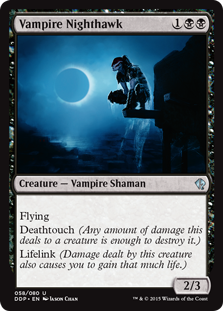 I love when expensive x/3 creatures see play. To Vampire Nighthawk's credit, she does fight with Brain Maggot for those Lightning Bolts. And thanks to Courtney's nine hard discard effects, opponents might have no choice but to shoot the Insect, giving Nighthawk even more room to breathe. She's incredibly versatile on the battlefield, trading up with big creatures, walling little ones, clocking in the air, and constantly netting life. (Imagine Nighthawk with a Lashwrithe!)
I love when expensive x/3 creatures see play. To Vampire Nighthawk's credit, she does fight with Brain Maggot for those Lightning Bolts. And thanks to Courtney's nine hard discard effects, opponents might have no choice but to shoot the Insect, giving Nighthawk even more room to breathe. She's incredibly versatile on the battlefield, trading up with big creatures, walling little ones, clocking in the air, and constantly netting life. (Imagine Nighthawk with a Lashwrithe!)
With Path to Exile decks on the decline, and Grixis Control gradually retreating into the shadows, Phyrexian Obliterator finally makes its move. Monoblack Devotion wasn't even the only deck at States to run Phyrexian Obliterator - Daniel Simmons took his B/G Rock deck to 7th place. Obliterator's fantastic against red removal and anyone trying to win on the ground, and it's got that mythical, 5/5 body. Its prohibitive mana cost becomes a non-issue with Courtney's 23 Swamps.
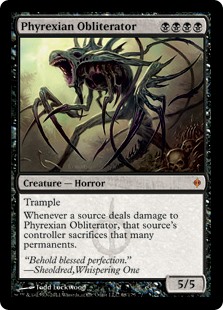 Obliterator provides an unshakable defense, but Demigod of Revenge seems like the real killer here. While Mana Leak can muck up Obliterator plays, it doesn't do much against Demigod, who revives his buddies on cast. Still, it never hurts to add in "reach" with Gray Merchant of Asphodel, another Siege Rhino surrogate who deals Corrupt-level damage with Obliterator or Demigod in play.
Obliterator provides an unshakable defense, but Demigod of Revenge seems like the real killer here. While Mana Leak can muck up Obliterator plays, it doesn't do much against Demigod, who revives his buddies on cast. Still, it never hurts to add in "reach" with Gray Merchant of Asphodel, another Siege Rhino surrogate who deals Corrupt-level damage with Obliterator or Demigod in play.
I think Courney's manabase could use a little work. Some combination of Urborg, Tomb of Yawgmoth and utility lands like Mutavault or Haunted Fengraf might upgrade the deck. I understand Courtney wants to hit that turn-four Obliterator as often as possible, but I'm not sure it's worth drawing so many blanks after five turns, especially with smoothing options like Urborg available.
Mardu Pox
Matthew Currie's 7th-place Pox deck doesn't pull any punches, running only Fulminator Mages as creatures and winning with planeswalkers against resourceless opponents. Currie grinds value out of games by flashing back Lingering Souls, turning useless life points into Faerie tokens, and casting "free" spells off Liliana and Gideon.
Mardu Pox, by Matthew Currie
So as not to interfere with his Smallpox plan, Currie leans on noncreature permanents to close out games. Bitterblossom creates a squad of expendable fliers, and Lingering Souls helps out. Gideon, Ally of Zendikar turns into an indestructible 5/5 (again, 5/5!) that reverts to planeswalkerdom in time for next turn's Smallpox. Lavaclaw Reaches supports whichever plan Currie chooses while providing a late-game mana sink.
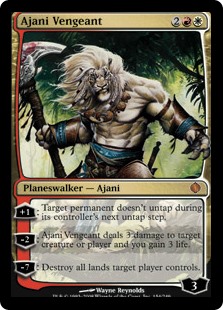 I've brewed many Pox decks in Modern and have always included Ajani Vengeant in these colors. He locks down precious lands, kills creatures, gains life, and builds up to a one-sided Armageddon. However, Gideon makes more sense in this slot as an actual threat, since Ajani won't usually win games on his own. I also like Gideon's ability to make blockers, and his ultimate's synergy with Currie's token effects.
I've brewed many Pox decks in Modern and have always included Ajani Vengeant in these colors. He locks down precious lands, kills creatures, gains life, and builds up to a one-sided Armageddon. However, Gideon makes more sense in this slot as an actual threat, since Ajani won't usually win games on his own. I also like Gideon's ability to make blockers, and his ultimate's synergy with Currie's token effects.
The most questionable include is Haunting Echoes, which has the potential to decimate an opponent's deck in the late game. I'm not sure it's better here than another threat. If an opponent's graveyard is full of cards because we've dealt with everything thrown at us, why not just win instead of prolonging the game further? With Echoes already costing five mana, Batterskull and even Obzedat seem like decent options. Both of these cards have myriad applications, whereas Echoes only does one thing. Draw power like more copies of Sign in Blood could also make the cut,
SCG States: Permanent-Based Midrange
I've had some trouble classifying prison decks and ramp decks in my discussion of Modern archetypes, so for this article, I'm grouping them both under the umbrella of permanent-based midrange. Like their attrition-based cousins, these decks find a way to get into their superior late game, either by disrupting opponents with cards like Thoughtseize and Ghostly Prison, or by ramping with Expedition Map and Overgrowth. Unlike those decks, permanent-based ones care less about time, and are content to play games that last 20+ turns. Comparatively, Abzan Midrange might feel uncomfortable going into games that long, since its Siege Rhinos will inevitably by overshadowed by Emrakul, the Aeons Torn. Permanent-based midrange decks in Modern include Tron and Death Cloud Ramp.
W/R Devotion
As with Esper Gifts above, I'll kick this section off with a deck less midrange and more control. One underexplored section of control is prison, an archetype that locks opponents out of the game with proactive, disruptive permanents, and then wins at its leisure. This archetype has never seen much success in Modern. Even with powerful cards like Chalice of the Void and Blood Moon, the format's diversity can often overwhelm these narrow effects. Brian Switzer doesn't care. He built a deck that resists and casts both Chalice and Moon - then, he relegated both hosers to the sideboard and played his way to 4th place.
W/R Devotion, by Brian Switzer
Pillow Fort is a mono-white, enchantment-based prison deck. It's not exactly new to Modern, but I find Switzer's build particularly interesting. Splashing is easy when you want scry lands anyway, but the red splash only supports two Ajani Vengeant in the mainboard, and three Blood Moon in the side. That isn't counting War's Toll, which I suppose forces bad combat steps when Switzer starts making angels. To be completely honest, I'm not sure what this card does or why it's here.
In last week's article, I was similarly stumped by Rob Wrisley's R/G Aggro deck. I reached out to Rob and he explained his choices, as well as the source of his deck, in the comments. Before I get in touch with Switzer, I'll ask you readers to decipher the War's Toll mystery.
Switzer's more obvious choices are Suppression Field, which turns off fetchlands, hurts Affinity, and stops Splinter Twin; Runed Halo, which grants "protection from Tarmogoyf" or whatever other beater opponents stick; and Banishing Light, a catch-all answer to problem permanents. Given the possibility of drawing multiple copies of Leyline of Sanctity or Blood Moon, or just of flooding out, I'd like to see some Faithless Lootings in this deck.
Tooth and Nail
Another Standard deck from a bygone era, Christopher Depue's Tooth and Nail is really a green devotion deck splashing blue for Kiora, Master of the Depths.
Tooth and Nail, by Christopher Depue
When Kiora, Master of the Depths was spoiled, I predicted she'd have a home in these decks: "Kiora slots into Modern’s Devotion to Green decks, which already sometimes splash blue for Kiora’s Follower, but usually stay GR. The planeswalker’s loyalty effects may push the deck into a preference for blue." Indeed, it seems Kiora shot this Tooth and Nail deck to 6th place, at once untapping lands enchanted by Utopia Sprawl or Overgrowth (or just Nykthos) and an Arbor Elf or Voyaging Satyr to do it all over again.
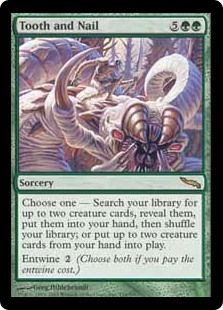 Tooth and Nail generally summons Emrakul, the Aeons Torn and Xenagos, God of Revels. Xenagos gives Emrakul +X/+X and Haste, and the game should end right there. Otherwise (say, thanks to an opponent's start-of-combat Deceiver Exarch to tap down the Eldrazi), the deck's permanents don't go anywhere, and Depue can repeat his assault the following turn.
Tooth and Nail generally summons Emrakul, the Aeons Torn and Xenagos, God of Revels. Xenagos gives Emrakul +X/+X and Haste, and the game should end right there. Otherwise (say, thanks to an opponent's start-of-combat Deceiver Exarch to tap down the Eldrazi), the deck's permanents don't go anywhere, and Depue can repeat his assault the following turn.
To complement Tooth and Nail at the top of the curve, Depue runs Harmonize, Gifts Ungiven, and Primal Command. These card advantage tools allow pilots to get way ahead on the board, search the namesake sorcery, and recycle the best spells with Witness.
Like Switzer, Depue includes a small red splash, this time for Blood Moon and Ancient Grudge. Interestingly, Choke shows up in greater sideboard numbers than Moon does, no doubt a nod to Modern's Remand decks. Sands of Delirium takes the cake as my favorite sideboard card of Depue's - sometimes, you just gotta kill 'em some other way!
Places That I've Never Been
All eyes are beginning to turn towards Pittsburgh. I doubt the Grand Prix will showcase the degree of brewing innovation found in the States results, but the format will certainly evolve after the tournament, for better or for worse. Here's to Modern's impressive diversity, and to hoping a rogue deck takes that GP trophy.





Hi I really enjoy your articles simply because innovation is what makes magic fun. The decks you searched together really show what is possible. I’m currently working on a Dega midrange deck but am unsure how to close things off. I currently have 3 butchers of the horde but don’t like them. Maybe demigod?
I really enjoy your articles simply because innovation is what makes magic fun. The decks you searched together really show what is possible. I’m currently working on a Dega midrange deck but am unsure how to close things off. I currently have 3 butchers of the horde but don’t like them. Maybe demigod?
Anyways great article you have a small mistake in it: The pillowfort is also called pox like the dega deck before it.
you have a small mistake in it: The pillowfort is also called pox like the dega deck before it.
Wow, thanks for picking that up! Stormbreath Dragon is a great option in Modern because it’s hard to kill and tough to chump.
Except that it dies to any removal that isnt Path or Bolt – which is Terminate, Dismember, Go for the Throat
As far as the meta game goes, you only see that in Jund and Grixis though.
War’s Toll and Ghostly Prison’s time to shine.
I don’t comment often on threads because I’m certainly not an expert when it comes to the modern meta, breaking down facts and figures, but I have been playing a three color prison deck in various forms for a long time now online so I feel confident that I can speak with some knowledge.
So why War’s Toll, synergy with ghostly prison (or suppression field) shouldn’t be overlooked. These two cards in conjunction force opponents to surrender control of half of their turn. Essentially, because ghostly prison’s tax must be paid during the attack step, an opponent must determine if they would like to cast spells (in either M1 or M2) or attack during a turn—they cannot do both. This is particularly damning against control decks which want to leave mana open for counters. War’s toll essentially acts a massive tax, forcing opponents to tap out forcing either inopportune plays—or dead turns. (if you’re giggles come from living on the edge as mine do, pair it with Manabarbs—and Runed Halo for extra giggles.)
I could extol the merits of prison decks in the current meta quite a bit, as you noticed, suppression field shuts down twin and fetchlands, but it also shuts down Griselbrand and planeswalkers, Aether Vial and anything that Cycles. Suppression field is a powerhouse, however, as a prison player myself I have to mention that in Currie’s build it also neuters his own Ajani Vengeant as well as Heliod. Now, of course once Nykthos gets up and running this is less of a concern, it can become an issue.
I like much of what Currie has done in his build, and Matt if you’re reading this, don’t let anyone bust your chops about running 4 Leylines in your main—as you know, the card hoses everything from Bolt to thoughtsieze to Gifts Ungiven (that’s right—Gifts targets opponents). What I don’t see in his build is a card that I believe has pushed Enchantment decks in to viability as a competitive option and that’s Starfield of Nyx. It’s a bomb that is very difficult for many decks to overcome. Yes, at 5 mana it’s a stretch to cast at times but, in my G/W/X builds it can be done as early as turn three with birds, utopia sprawl, and herald. Currie’s deck clearly has some great competitive elements and with a knowledgeable pilot behind the wheel, Nevermore can be crippling to huge swaths of the meta.
From the stand point of Sideboarding, I like much of what Currie is doing, all except Chalice of the Void (I just prefer Defense Grid). Kor Firewalker is good, although Sanctimony trigger’s Sigil and beefs up Sphere of Safety, is easier to cast, and is harder to remove. But it can’t block Ravager of the Fells or Vexing Devil so, it’s a personal choice.
From my novice point of view, the redundancy in Currie’s build might be more of a detriment than a boon in some cases (this was my experience…) Opening hands consisting of 2 or 3 five drops can happen quite frequently with this deck and in this meta that’s a must mull—even if you have 3 lands. For me, this is where Green becomes a must have.
I can’t stress how much more consistent my play has been with green in the build. W/G/X allows me to consistently drop a turn 2 Ghostly prisons via G/X Shock and Utopia Sprawl/Birds of Paradise. Eidolon of Blossoms, while very boltable, is a remarkable source of card draw—particularly with Heliod and Nykthos. Don’t forget, it becomes a 4/4 with Starfield. Green also provides us with Eye’s of the Wisent as a board optioni (or voice if you want the critter) helping to keep counter-based control honest.
As of right now, I’m playing 3 versions of the deck
Abzan build which utilizes Doomwake Giant to help keep the board clear, Phyrexian Arena, and Abzan Charm. This build is an attrition build in which I draw and draw and draw to get to Heliod, Sigil, or Starfield and win.
A Bant Build which utilizes Gifts Ungiven to go and fetch up Starfield, Eternal Witness, Open the Vaults, and Omniscience. Bant gives us access to Serum Visions and Monastery Siege which helps us dig for our prisons and wincons
Naya gives us access to the aforementioned War’s Toll and Manabarbs, as well as Pyrohemia or Ajani (if you don’t mind paying activation costs) and Faithless Looting, which does wonders for enabling Starfield. We use Citadel Siege to help us move through the deck a bit faster. This build requires Runed Halo in the main, but that card is amazing so it’s not a problem.
Can these decks stand up to everything? No, Tron, Amulet Bloom, and elves (damn you archdruid!) tend to be issues, for me at least. But fish, twin, tokens, jund, affinity, burn, zoo, etc. against these decks—we can even the odds and make help make the meta a bit more fair—and in this linear world, couldn’t we all use a bit more fairness?
I hope I haven’t written too much.
Thanks for all you do with this site, I love it. And have learned a great deal from you guys. Keep up the great work.
Nice insights. I especially like the idea of Starfield of Nyx… with Fatihless Looting.
Hey Dan, are you on tappedout.net at all? I’ve been throwing around making a pillowfort primer on there, I just suck at writing. Maybe you would be interested in working on one with me?
That aside, I’m a pillowfort brew builder too; I enjoy playing with 5 colors, for example here http://sales.starcitygames.com/deckdatabase/displaydeck.php?DeckID=73318, but I’ve recently just been trying the two colors. I think the hardest time we have, overall, is permission decks. But, I like how you are willing to play non-enchantment cards, like faithless looting. Pretty cool.
As usual, I’m a fan of the article, Jordan. Allow me to offer up some comments:
1) I like the concept of this list (and I love the Obzedat backup plan), but are we really hitching our wagon to Monastery Siege as protection? Maybe it will work out better for a deck with a more deliberate gameplan than it did for Merfolk (where most players have moved on from the card, and the ones that haven’t likely will soon), but my opinion is that it comes out too late to matter. And if it’s there for the perma-loot, it feels a bit redundant with having 4 Jaces (and no, I don’t consider that it protects Jace a whole lot, since he dies to a stiff breeze).
2) I’m a bit leery of MBD given that it has no ability to interact with artifacts or enchantments (so no beating Lantern Control, Prison, or Affinity, ever), but that deck looks really fun. It also looks to be reasonably resilient (though I worry about Lashwrithe in a format where Kolaghan’s Command is so popular). I think I might want to experiment with Complete Disregard, Geth’s Verdict, or a small splash in order to handle creatures with pro-black.
3) This deck looks mean. It durdles a bit much for my taste (no matter how many lands you run, 4+ mana win-cons in a deck that blows its own lands up screams slooooooow), but it would probably be a bear for a lot of decks that don’t have countermagic, ramp, or the ability to vomit out their hands quickly to deal with.
4) I don’t think that splashing R just for War’s Toll (whose land trigger I’m assuming you can respond to by floating all of your mana and casting stuff – feels a bit underwhelming), Ajani Vengeant, and Blood Moon is worth it. It’s fine if you want to avoid the CMC1 removal (though Bolt in particular would be great here, since it avoids the non-bo that is Path + Ghostly Prison), but you have to at least think about cards like Lightning Helix and Wear // Tear.
5) I’ve taken an “all-in” variant of that Tooth & Nail list out for a spin. I doubled down on the combo by using Garruk in addition to Kiora, Fertile Ground in addition to Utopia Sprawl and Overgrowth, and Kiora’s Follower in addition to Arbor Elf and Voyaging Satyr). The deck is a blast to play, and I also found it to be redundant enough (and possessing enough cantrip power, thanks to Serum Visions and Harmonize) to shrug off the initial wave of disruption attempts. The Gifts version has its merits, but I’m not sure they trump just being really consistent on your comboing off.
Hey there Roland,
Regarding Currie’s deck. I’d argue that Ajani is the purpose for red in his build. The synergy between War’s Toll and Ghostly Prison/Suppression field is the reason we play it. Yes, a player can float all of their mana in response to the tap trigger. But when that mana fizzles as the phase ends, it leaves the player unable to attack as they can’t pay the Ghostly tax. Conversely, should they decide to wait until the attack step to pay for an attack, this leaves them without the ability to cast spells during main phase two, or our turn.
The deck has some weaknesses to counter control–War’s Toll helps mitigate this by limiting the opponents options to attacks, or spells.
As Jordan noted below, Defense Grid accomplishes the “protect me from countermagic” effect for just 2 mana, and making people choose between tapping for Ghostly or casting something doesn’t sound overly significant, given that it’s what most people opt to do anyway. The creature-based effect is also close to irrelevant in Prison, since you’re not tagging them on a backswing. I don’t think War’s Toll is all that great an effect, and certainly not for a whopping 4 mana.
I get splashing red for Ajani (he’s pretty great), but you might as well grab other good things in red while you’re there. I don’t see much reason to not pack Lightning Helix, given that the first few turns of this deck’s games are it hanging on for dear life until it can stabilize. The swing from removing an attacker and getting life is absolutely huge, especially against a burn deck or any other deck with reach that can ignore your lock effects.
The problem with an all-in Tooth deck is its weakness to countermagic, but Leak + clock is already hard for these kinds of decks to beat. On War’s Toll, I mostly agree with you. It seems to me like a jankier, two-card (still), eight-mana Isochron + Silence. Or, if the goal is to pacify counterspell decks, a jankier, eight-mana, two-card Defense Grid that only works against opponents with creatures.
Well, the idea with all-in Tooth is to survive your guys being Bolted, or generate so much mana that Mana Leak just stops working properly. Given that slower hard counters like Cryptic Command are sort of being hated out of the format right now by all of the aggression, it’s not the worst idea.
And I think you’ve explained my thoughts on War’s Toll better than I have – it just reeks of jank.
Oh, hey fellas, I didn’t mean to imply that I disagree with you regarding War’s Toll, your assessment as usual is probably spot on. Especially, for competition at the highest levels. I’m simply trying to relate its general purpose in the deck. Where I’ve used it, I’ve had some decent results–however, neither my local meta nor MTGO provide pro level competition consistently, so take my statements for what they’re worth. It may be out of the box, but Currie seems to have done fairly well. If worked for him great, but It may not be everyone’s cup-o-tea. I think he’s crazy for not running green for its ability to accelerate the deck (something I think the deck badly needs) but again, I’m hardly an expert. I just enjoy seeing new decks challenge the meta in new ways.
As far as removal goes, Roland’s ideas regarding lightning helix seem great to me. I also forgot to mention that I’ve learned a great deal about modern from his comments as well while visiting the site. Lastly, don’t sleep on enchantment removal like Porphyry Nodes, they can be very potent. Although it tends to remove it self when Starfield lands, so that’s something to consider.
Green is something to consider for sure. It could potentially evolve from a pillowfort deck to an enchantress type of deck, though I’d really have to look the cards over to be sure. Porphyry Nodes would feel real bad in that hypothetical enchantress deck, unfortunately, because the creatures that you tend to want to mine for value are wimpy from the body POV.
And thanks for the shout-out man. I appreciate it.